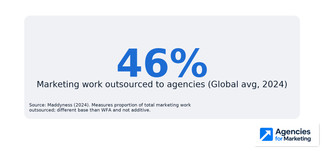State of Marketing in the U.S. 2025 Report
- Abraham Chera

- Aug 18
- 25 min read
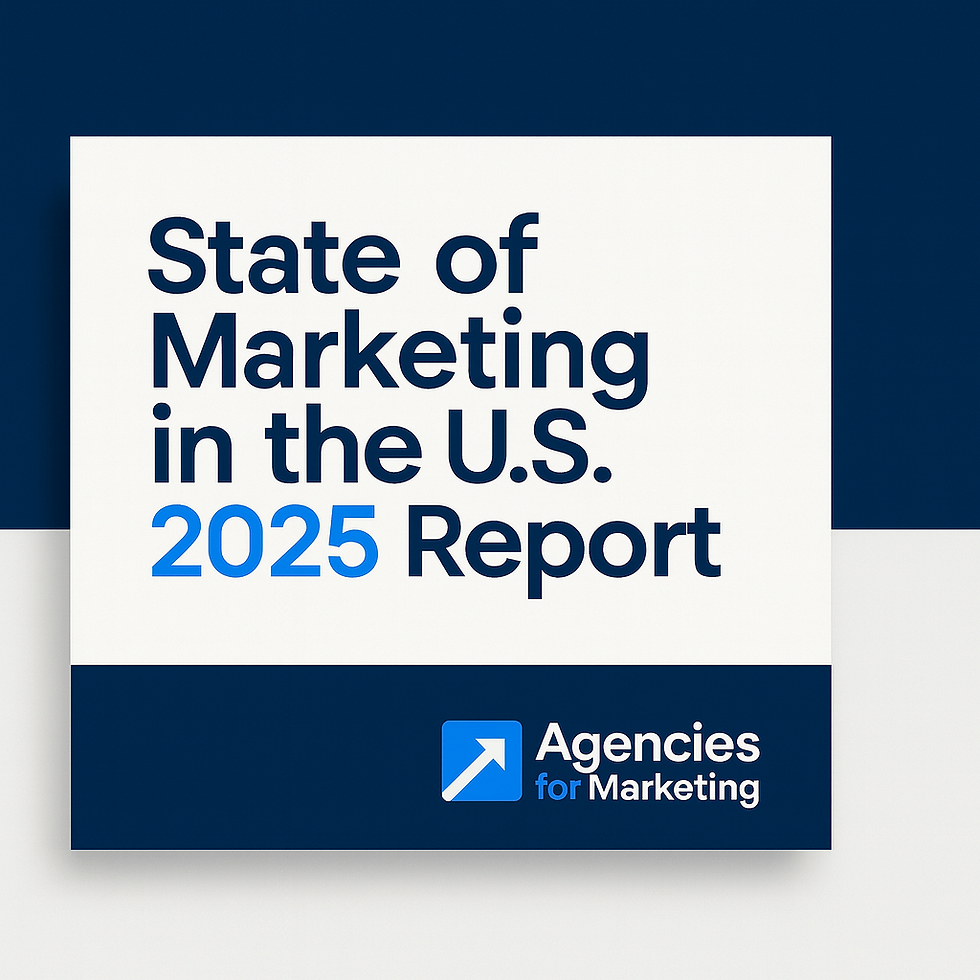
The marketing industry is experiencing its most significant transformation in over a decade. Marketing in 2025 is evolving at breakneck speed, driven by social media’s dominance, emerging technologies, and changing consumer expectations. In the United States, one of the world’s largest advertising markets, brands are reinventing how they connect with audiences. Key trends defining the current landscape include the mainstream rise of influencer marketing, a reevaluation of in-house vs. agency marketing models, the transformative impact of AI, the boom in short-form video content, and shifting consumer behavior and trust dynamics. This comprehensive report delves into each of these areas with recent data and insights, providing a clear picture of where marketing stands today.
The goal is to arm marketers, marketing agencies, and business leaders with credible, up-to-date information from statistical benchmarks to expert commentary that will make them say “wow” at how far the industry has come and where it’s headed next. All insights are backed by reputable sources, including leading agencies and research firms, to ensure accuracy and credibility.
Influencer Marketing: From Niche to Mainstream Strategy
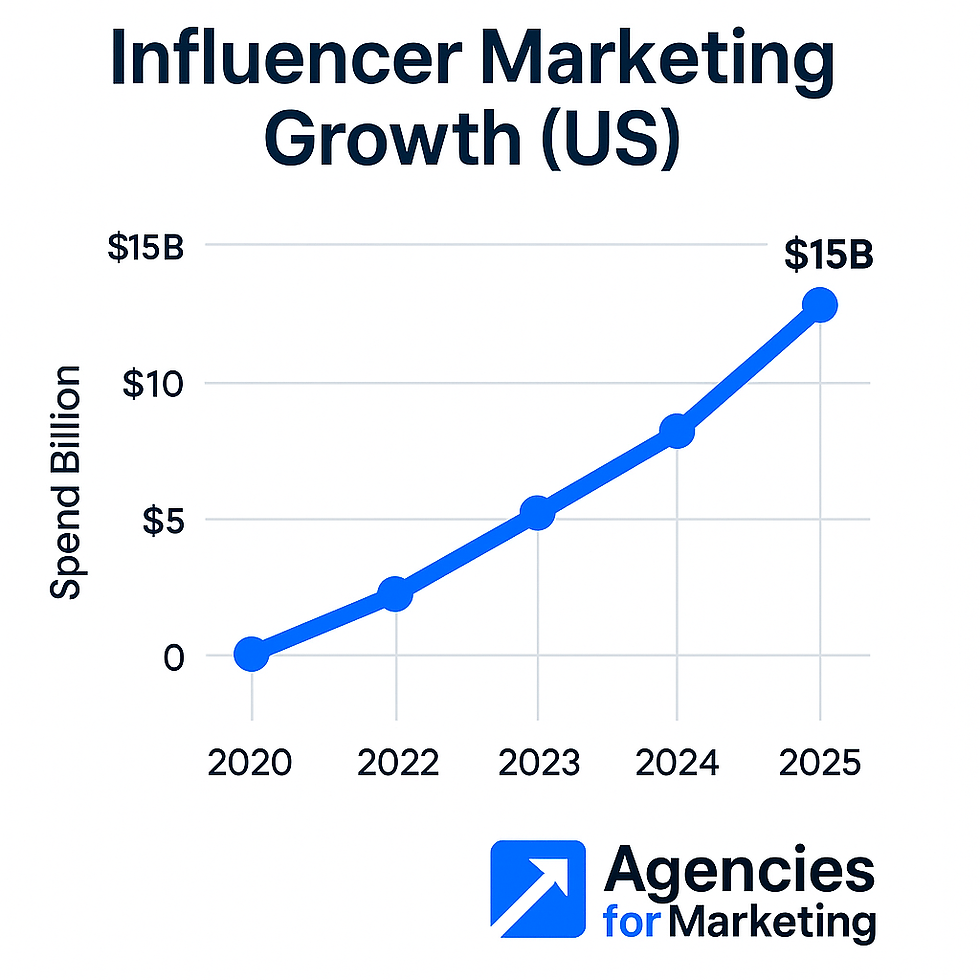
Once a niche tactic, influencer marketing has become a cornerstone of modern advertising. Brands of all sizes now collaborate with social media creators to drive awareness and sales. The numbers tell a dramatic growth story: globally, influencer marketing is projected to reach $32.5 billion in market size by 2025, up from $24 billion in 2024, according to the influencer marketing benchmark report for 2025. That represents a stunning 33% compound annual growth rate, cementing influencer collaborations as a mainstream channel. In fact, over 80% of marketers say influencer marketing is a highly effective strategy, and nearly 64% of brands plan to increase partnerships with influencers in 2025. The United States is at the forefront of this boom. U.S.-based influencers produced about 18.9 million sponsored posts in 2024, accounting for 22.7% of all sponsored posts worldwide, the largest share of any country. In other words, the U.S. is the single biggest market in the global creator economy.
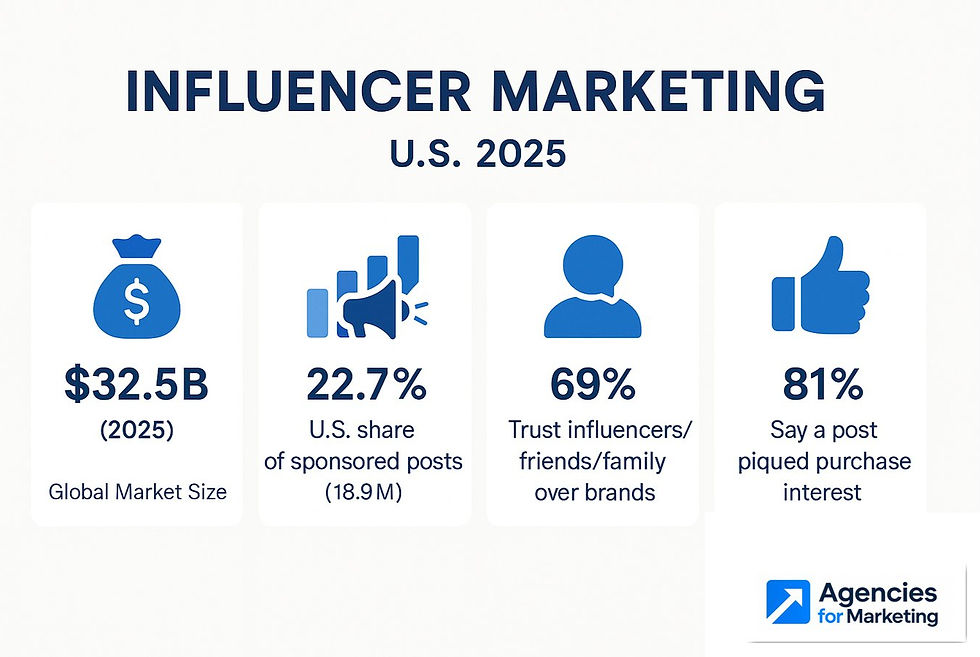
Why are so many marketers doubling down on influencers? A big reason is consumer trust. Modern consumers (especially younger generations) tend to trust recommendations from real people over traditional ads. According to a 2023 study by Marketing Dive, 69% of consumers trust influencers, friends, and family more than information coming directly from brands. It’s no surprise, then, that 81% of consumers said a social media post by an influencer or acquaintance piqued their interest in a product or service in the past year.
Influencers come across as more authentic and relatable, which can cut through ad fatigue. This is particularly true for Gen Z: nearly 40% of Gen Z consumers say influencer content impacts their purchase decisions most, more than any other content type, according to Sprout Social’s findings on how Gen Z uses social media. And over 8 in 10 Gen Z social media users follow influencers, with more than half following “many” influencers regularly, according to Morning Consult. These stats underscore that influencers have become key intermediaries between brands and the coveted younger audience.
Another factor is raw engagement and ROI. Short-form influencer content often generates significantly higher engagement rates than brand-produced content. For example, one report found influencer posts can drive 8.8× more engagement than brand posts on social media, according to Boston-based marketing agency Torro. Moreover, marketers report strong returns: short-form video, a standard format for influencer campaigns, now delivers the highest ROI of all marketing tactics and is attracting the most new investment heading into 2025. Brands are realizing that money spent on creators can outperform equivalent spend on many traditional ads, provided the partnership is well-executed.
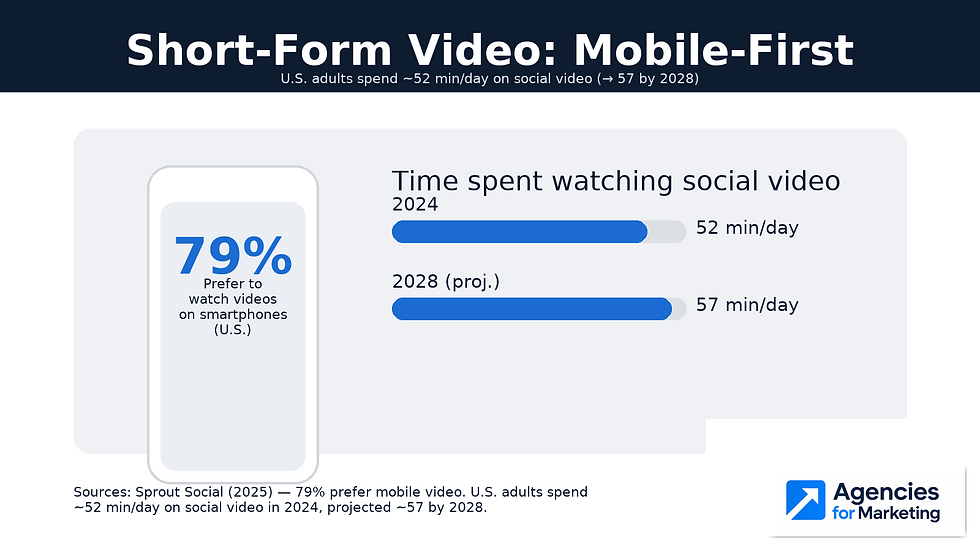
Significantly, influencer marketing has matured beyond one-off sponsorships. There’s a rise in long-term partnerships and an emphasis on authenticity. Many brands are working with micro-influencers and niche creators whose communities are small but highly engaged and trustworthy. In 2024, for instance, nano-influencers (those with very small follower counts) made up 75.9% of Instagram’s influencer base, reflecting how brands value even “everyday” creators for their closeness with audiences. The industry is also professionalizing: an entire ecosystem of agencies, platforms, and tools now supports influencer campaigns. Over 6,900 companies and service providers specialize in influencer marketing in 2025, up dramatically from just around 1,100 in 2019. This includes influencer marketing agencies that connect brands with vetted creators and manage campaigns at scale.
“2024 will put influence in a leading seat. This is the year that influence moves from a nice-to-have component of a brand’s marketing stack to an essential tool for growth and brand awareness.”, Rahul Titus, Global Head of Influence at Ogilvy, 2024.
Industry surveys echo Titus’s point: more than 80% of marketing agencies and B2C brands now work with influencers, significantly higher adoption than a few years ago. Marketers have grown more sophisticated, tracking ROI and demanding data-driven results from influencer campaigns. There is also a push for authentic content; consumers can sense overly scripted influencer ads, so brands now strive to give creators creative freedom and seek genuine endorsements. With regulatory bodies like the FTC keeping a close eye on disclosure, transparency is improving, further boosting audience trust.
All signs point to influencer marketing’s role only growing. Insider Intelligence forecasts that advertiser spending on influencers would top $6 billion in the U.S. in 2023 and continue climbing. As social platforms integrate shopping tools and live streaming, creators are becoming full-fledged commerce partners. The bottom line: Influencer marketing in the U.S. has evolved from an experimental tactic into a mainstream, big-budget channel, thanks to its ability to drive authentic consumer engagement at scale.
In-House vs. Agency: Finding the Right Marketing Model
With marketing expanding into so many specialized areas (from TikTok to AI-driven personalization), companies face a crucial decision: do we build in-house marketing capabilities or partner with external agencies? In recent years, many U.S. brands, especially large advertisers, have explored bringing more marketing work in-house. A 2023 survey by the World Federation of Advertisers found that 21% of brands were considering establishing an in-house agency, up from 17% in 2020. Additionally, about two-thirds of major advertisers already operate an in-house agency, and over half of those plan to move more functions (like digital content production) internally in the next few years. The main drivers cited are cost efficiency (83% of respondents) and increased agility/speed (76%). Simply put, some companies believe they can save money and respond more quickly by handling marketing themselves rather than paying outside firms.
There is evidence that in-housing can work well in certain areas. Satisfaction with in-house teams has been rising as these teams mature. In the WFA survey, 86% of brands were satisfied with their in-house agency’s output, and one-third reported being “completely satisfied,” a significant jump from three years prior. Many of these internal teams are new (nearly 75% were less than 5 years old), but they are quickly gaining sophistication and taking on strategic roles like brand creative and media planning. High-profile marketers like Procter & Gamble have publicly touted savings of “tens of millions” by bringing certain media and creative duties in-house. Especially with the rise of data-driven marketing (and impending loss of third-party cookies), companies want to own their data and customer insights, which fuels the in-house trend for analytics and programmatic media buying.

However, the pendulum swinging toward in-house does not spell the end of agencies. Recent data shows a parallel trend: many businesses are also increasing their use of external agencies in specific areas. A 2024 report noted that across businesses globally, 46% of marketing work was outsourced to agencies, up from just 25% in 2020, according to an article by Maddyness. In other words, while some companies built internal teams, many others (including smaller businesses) have turned to agencies for help amid the growing complexity of marketing. The total number of marketing agencies has continued to climb, reaching 433,000 agencies worldwide in 2024 (a 2.6% increase from the previous year), according to Fortis Media. The U.S., home to advertising giants like the big agency holding companies, constitutes a large chunk of that figure. Agencies remain in high demand to provide capabilities that organizations might lack internally.
The value of partnering with a marketing agency lies in the breadth of expertise and resources agencies offer. Agencies live and breathe marketing innovation across industries, which gives them a broader perspective. Owen Garitty, founder of FPW Media, describes the perennial dilemma:
“Businesses are plagued by a never-ending quandary, whether to hire an in-house marketer or contract a marketing agency. Proponents of an internal team might say it’s more cost-efficient and personalized. Still, the reality is that working with a marketing agency offers numerous benefits that many businesses don’t consider.”
Those benefits are indeed compelling. First, agencies bring specialized skills and diverse talent that would be costly for a company to assemble on its own. As marketing author Simon Kingsnorth points out, an agency gives you instant access to experts in everything, “from copywriting and PPC campaigns to graphic design and videography,” without the overhead of hiring full-time staff for each role. “There’s no need to go through the hassle of hiring and managing your marketing dream team when an agency already has everything you need,” Kingsnorth says. This on-demand talent model is especially valuable for smaller brands that need high-quality output in multiple areas (creative design, social media, SEO, etc.) but can’t justify dedicated hires for each.
Second, agencies provide scalability and flexibility. If your marketing needs suddenly expand (for example, launching a major campaign or responding to a viral trend), an external agency can ramp up resources quickly, something an in-house team might struggle with if headcount is fixed. Conversely, you can scale down with an agency after a project without the HR implications. This flexibility is one reason outsourced marketing efforts grew in recent years; companies sought adaptable support during the volatile pandemic period and beyond.
Third, top agencies have state-of-the-art tools and industry networks. A good agency stays on the cutting edge of marketing tech, whether that’s AI-based analytics or emerging social platforms, and can apply those tools to your campaigns. They also have established relationships in the industry.
“Marketing agencies typically have a wide network of connections and relationships within the industry. This established network can provide access to new opportunities and resources, leading to even more impactful marketing strategies,” says Owen Garitty.
For example, PR agencies maintain media contacts, and influencer agencies have rosters of vetted creators. By tapping into those networks, brands can achieve placements or partnerships that might be out of reach otherwise.
Finally, and perhaps most importantly, agencies offer an outside perspective and creative firepower. An in-house team lives and breathes one brand every day, which can sometimes lead to tunnel vision. Agencies, on the other hand, work across multiple brands and sectors, cross-pollinating ideas and best practices. They are often better positioned to come up with “big ideas” that break through the noise. Publicis Groupe CEO Arthur Sadoun, who leads one of the world’s largest agency organizations, argued that creativity is the ultimate differentiator that agencies bring. In a recent interview, Sadoun emphasized that even as content creation becomes democratized, brands still risk falling flat without a strong creative strategy: “Without strategic and creative guidance from someone who understands the brand and the context, placing the brand narrative completely in the hands of creators can miss the point or backfire… And no one can do that better than agencies.” In other words, agencies excel at bridging the gap between a brand’s objectives and the creative execution, ensuring that campaigns aren’t just frequent or on-trend, but also on-message and effective.
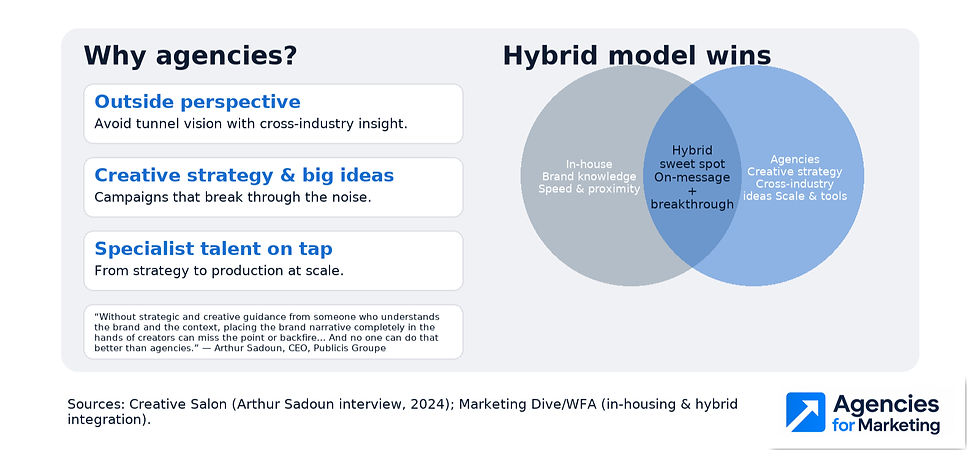
It’s worth noting that the optimal model for many companies is a hybrid: maintaining an in-house team for core brand knowledge and quick-turn needs, while leveraging agencies for specialized campaigns, overflow capacity, or high-level strategic and creative work. Integration can be a challenge (as some brands report difficulty aligning internal and external teams), but when done right, it offers the best of both worlds. As Stuart Pocock of The Observatory International put it, the key is making sure in-house teams don’t just churn out content for the sake of volume; quality and strategy must remain paramount. Agencies often help uphold that quality bar.
In summary, agencies continue to demonstrate their value in the U.S. marketing industry, even as in-house capabilities grow. The decision isn’t either/or for many firms; it’s about finding the right mix. The data shows agencies are far from obsolete; in fact, agency revenues and involvement are still robust. As marketing becomes more complex (think AI, omnichannel campaigns, creator economies), the expert guidance, breadth of skills, and creative innovation that agencies provide can be a decisive advantage for brands navigating the chaos. Or, as Garitty succinctly states, working with an agency unlocks “numerous benefits” that can complement what internal teams do. For businesses seeking to maximize marketing impact, agencies remain a critical piece of the puzzle in 2025.
The Impact of AI: Marketing Enters the Age of Intelligence
Perhaps no force is poised to shape the future of marketing more than artificial intelligence (AI). In 2023 and 2024, the buzz around generative AI, machine learning, and marketing automation reached a fever pitch, and marketers have moved from talk to action. According to a recent industry benchmark survey, over 69% of marketers have already integrated some form of AI into their marketing operations as of 2024, reflecting broad acceptance of AI across the industry. Separate research by Epsilon found an even higher adoption rate, claiming 94% of marketing organizations use AI in some capacity for preparing or executing campaigns. While methodologies differ, the takeaway is clear: AI is no longer futuristic hype; it’s here and now in the marketing toolkit.
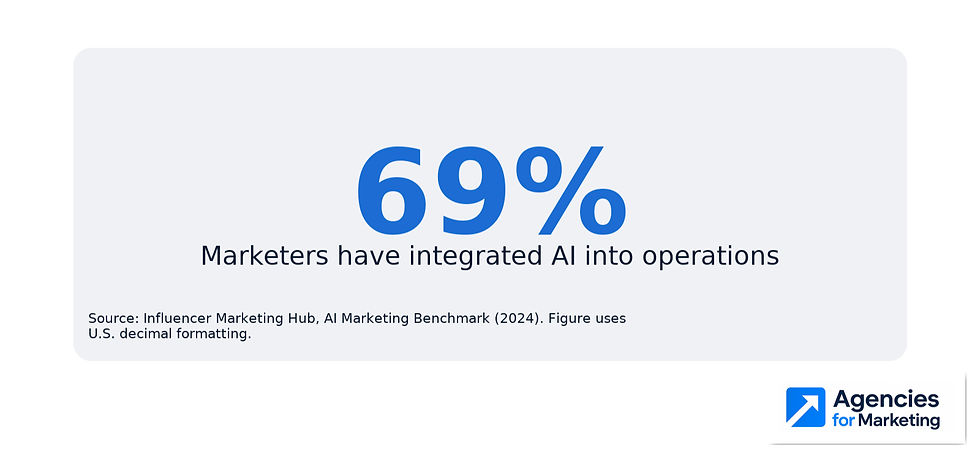
The applications are wide-ranging. AI is being used to generate content (from social media captions to entire blog posts), to automate repetitive tasks (like email sends and ad bidding), to analyze customer data for insights, and to personalize consumer experiences at scale. For example, surveys show about 38% of marketers leverage AI specifically for content creation (such as drafting copy or social posts), and a full 64% use AI to derive deeper customer insights from data. AI-driven tools can segment audiences, predict behavior, and even optimize creative elements on the fly. Marketers are increasingly entrusting algorithms to handle tasks such as media buying. One report noted that over 50% of marketers use AI to optimize or personalize content for audiences.
The rise of generative AI in particular has been a game-changer. Breakthroughs like OpenAI’s GPT-4 and now GPT-5 and other advanced models emerged, and marketers eagerly experimented with them for creative work. In a 2024 survey, 42.2% of marketers said generative AI (e.g., GPT-4) had already led to transformative changes in their marketing strategies, reshaping how content is created and how campaigns are managed. From auto-generating video scripts and imagery to writing personalized product descriptions, generative AI has supercharged content production. Notably, many marketers are seeing positive results: about 34% reported significant improvements in marketing outcomes directly attributable to AI implementation, such as better engagement or higher ROI from AI-optimized campaigns. 68% of companies say AI has boosted their content marketing and SEO ROI, and those that consider themselves “highly successful” in content marketing and SEO are overwhelmingly likely to be using AI tools (82% of such companies use AI). These figures suggest that, when used smartly, AI can enhance efficiency and performance.
The enthusiasm is evident in budget trends as well. Nearly 20% of marketers in 2024 have already allocated over 40% of their marketing budget to AI-driven campaigns and tools. Looking forward, the market for AI in marketing is booming, estimated at around $20 billion in 2024 and projected to reach $27 billion in 2025 in terms of industry revenue, on a trajectory to quadruple by 2030. Both martech vendors and agencies are racing to infuse AI into their offerings. For instance, major agency holding companies have invested heavily in data and AI capabilities: Publicis Groupe spent the past decade investing over €9 billion in AI, data, and tech (acquisitions like Sapient and Epsilon) to integrate AI across its services. WPP, Omnicom, and others have similarly rolled out AI platforms for creative development and media optimization. The consensus is that AI is becoming table stakes for marketing success.
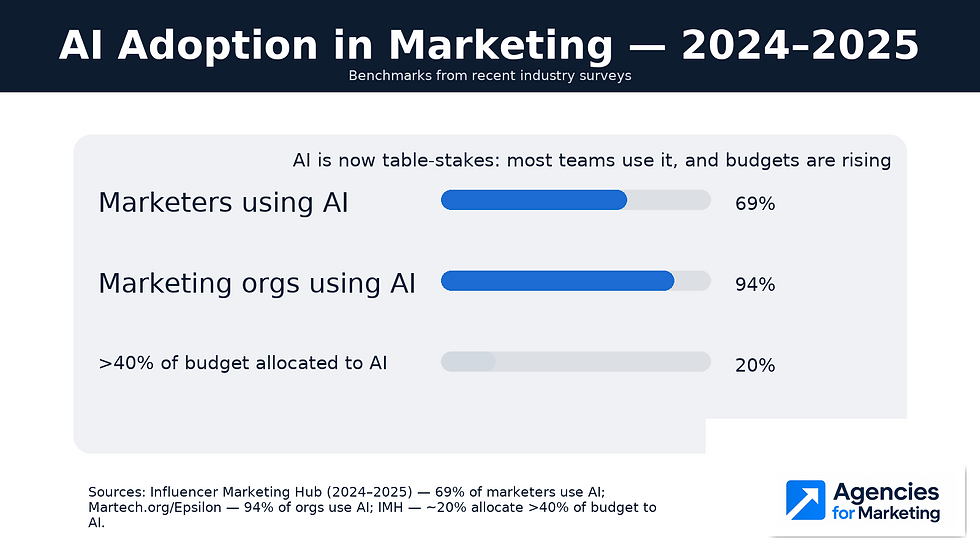
At the same time, the AI revolution brings concerns and a learning curve. Interestingly, while most marketers are embracing AI, many are also wary of its implications. In one survey, 70.6% of marketers said they believe AI can outperform humans in key marketing tasks, a sign of strong confidence in AI’s capabilities. Yet nearly 60% also admitted they fear AI could eventually replace their own roles. This anxiety has roughly doubled since the year prior, reflecting growing awareness that AI could disrupt marketing jobs if people don’t upskill. The fear isn’t unfounded: AI can already generate content, crunch data, and even design basic creatives faster (and often cheaper) than humans. However, industry leaders emphasize that AI is a tool to augment human creativity, not a replacement for it. Adobe’s CEO Shantanu Narayen encapsulated the imperative for marketers to adapt, saying, “AI adoption is non-negotiable; people who use AI will replace those who don’t”. In Narayen’s view, much like the computer revolution, those who leverage AI will outperform those who stick to old ways. Yet Narayen also noted that while AI may disrupt creative workflows, Adobe sees it as a “catalyst for new skills, not a threat to original craft”. In other words, human creativity and strategy remain vital; AI can handle the heavy lifting of execution or analysis, freeing humans to focus on big ideas.
Publicis CEO Arthur Sadoun offered a reassuring perspective from the agency world: “We’ve all heard the question: ‘Will AI replace creative talent?’ The answer is simple: of course not.” Sadoun explained that at his agencies, they see no fear or resistance to integrating AI; in fact, creative teams are “pushing to explore the applications of these new tools… with the knowledge that ultimately, it’s human talent that will bring the real creative value to the final product”. This view of AI as a powerful assistant rather than an autonomous mastermind is shared by many top marketers. AI can generate a hundred ad variants or analyze millions of data points in seconds. Still, it takes human judgment to choose the right message, ensure brand authenticity, and emotionally connect with consumers. The partnership of human + AI is the ideal. For example, an AI might provide data-driven audience insights and even draft a personalized email, but a marketer will tweak the tone to make it truly resonate. We see this hybrid approach in practice already: one study found 44% of marketers use AI to enhance the quality of their content, rather than creating it from scratch. And in content teams, while 54% of marketers now use AI to brainstorm ideas, only 6% entrust it to write complete articles without human input.
Going forward, we can expect AI to be embedded in nearly every marketing function, often invisibly. From more innovative chatbots handling customer service, to AI-curated product recommendations, to automated media buying systems that allocate budgets in real time, AI will underpin the marketing engines of most companies. The key for marketers in 2025 and beyond is to stay educated and experiment. Notably, among marketers who haven’t adopted AI yet, the most significant barrier (cited by 71.7% of non-adopters) is simply a lack of understanding of AI. Overcoming this through training is crucial because AI proficiency is becoming as important as social media savvy was a decade ago. Those that embrace AI strategically are already reaping rewards, whereas those who ignore it risk falling behind.
In summary, AI’s impact on marketing is undeniable and transformative, particularly in the U.S., where tech adoption is high. It brings efficiency, scale, and precision from automating simple tasks to uncovering patterns no human could see. But it also raises the bar: marketers must combine data-driven insights with human creativity to stand out. As one report succinctly put it, “people who use AI will replace people who don’t… but big ideas, not big algorithms, will win the day.” The winners in this new era will be those who leverage AI’s power without losing the human touch that makes marketing truly connect with hearts and minds.
The Boom of Short-Form Video and Visual Content
Scroll through any social media feed today, and it becomes obvious: video has taken over as the dominant content format. In particular, short-form videos (think TikTok clips, Instagram Reels, YouTube Shorts, etc.) have exploded in popularity and marketing significance. For the first time, in 2024, short-form video became the #1 content format used by marketers, surpassing blogs and static images. Roughly 29% of marketers say short videos are the most utilized content type in their strategy, slightly edging out images (28.9%) and far above traditional blog posts. This reflects a broader consumer shift; audiences are spending more time watching snackable video content and less time with text-heavy media.
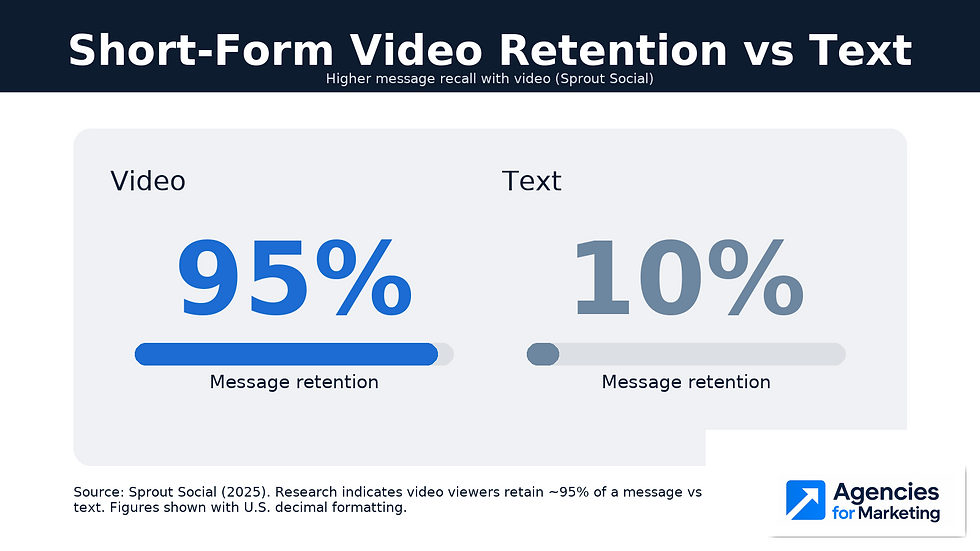
The engagement metrics around video are staggering. Viewers retain 95% of a message when watched in a video, compared to only 10% when reading text, according to research. That is an almost tenfold increase in information retention, which is gold for marketers trying to land a brand message. It’s no wonder that a recent HubSpot survey found short-form video delivers the highest ROI of any marketing trend today, and businesses plan to boost their video investments more than any other format in 2025. Marketers have caught on that a clever 30-second video can pack more punch and achieve more virality than a dozen static ads.
The user base and time-spent stats underscore how crucial short videos are in the U.S.: TikTok now boasts over 150 million American users, many of whom spend hours on the app per week, and platforms like Instagram and Facebook have retooled themselves to prioritize video content (Reels) to keep up. On average, U.S. adults spent about 52 minutes per day watching social video content in 2024, and that is projected to rise to 57 minutes by 2028. Separately, an average internet user globally already watches about 17 hours of online video per week as of 2023, a number that has been increasing each year. These videos aren’t all long-form TV shows or YouTube vlogs; much of this growth is from quick-hit videos on mobile devices. Notably, 79% of U.S. consumers now prefer watching videos on their smartphones (as opposed to laptops or TVs), illustrating how mobile-first the content strategy needs to be. Short videos perfectly fit mobile usage, filling those spare moments throughout the day with entertaining or informative clips.
From a marketing perspective, short-form videos check many boxes. They are highly engaging, often generating lots of comments and shares (especially if they tap into a meme or trend). They cater to dwindling attention spans, delivering a brand message in 10–60 seconds, which is crucial when consumers are inundated with content. They also lend themselves to algorithmic boosts; social platforms love to surface viral short videos to keep users hooked. For brands, this means a creative TikTok or Reel has the chance to reach millions organically, something that is much harder to do with text or image posts. According to Wyzowl’s annual survey, 89% of businesses are now using video as a marketing tool in 2025, and a majority of video marketers say short-form clips (under a minute) yield the best results. 66% of marketers consider short-form content the most engaging format on social media.

Crucially, short-form video isn’t just for awareness; it’s driving sales through new commerce features. TikTok’s hashtag challenges and product review videos can directly boost product sell-outs (the “TikTok made me buy it” phenomenon), and platforms are adding buy buttons and shopping integrations to capitalize on that. Instagram, for instance, enables shopping tags on Reels, and YouTube Shorts is experimenting with shopping links. Marketers are thus using short videos at multiple stages of the funnel: quick brand storytelling at the top, influencer testimonials or explainer clips in the consideration phase, and even how-to or unboxing videos post-purchase to increase usage and loyalty.
Some noteworthy trends within short-form video: optimal video length varies by platform. Research shows that on Instagram and Twitter(X), clips under 15 seconds tend to perform best, whereas on TikTok, the sweet spot is 15–60 seconds, and on YouTube (including Shorts) slightly longer videos (60+ seconds) can do well. This indicates that while “short-form” is the theme, marketers still need to tailor content to each channel’s audience behavior. Another trend is the use of AI in video creation; over half of video marketers (51%) have now used AI tools to help create or edit videos, including automatic captioning, video summaries, and AI-generated spokespeople. This marries the AI trend with the video trend, enabling faster production of quality video content.
“Video will continue to dominate social media, especially short-form video. Marketers need to double down on snackable videos optimized for mobile.” Sprout Social, 2025 Video Report
The dominance of short-form video doesn’t mean long-form is dead. Platforms like YouTube and podcasts show an appetite for longer content in specific contexts, but for social media marketing in 2025, quick-hit videos are king. Brands are advised to produce a steady cadence of bite-sized videos that entertain, inform, or inspire in under a minute. Whether it’s a behind-the-scenes peek, a customer testimonial, a how-to demo, or a humorous skit, these pieces keep the brand relevant in social conversations.
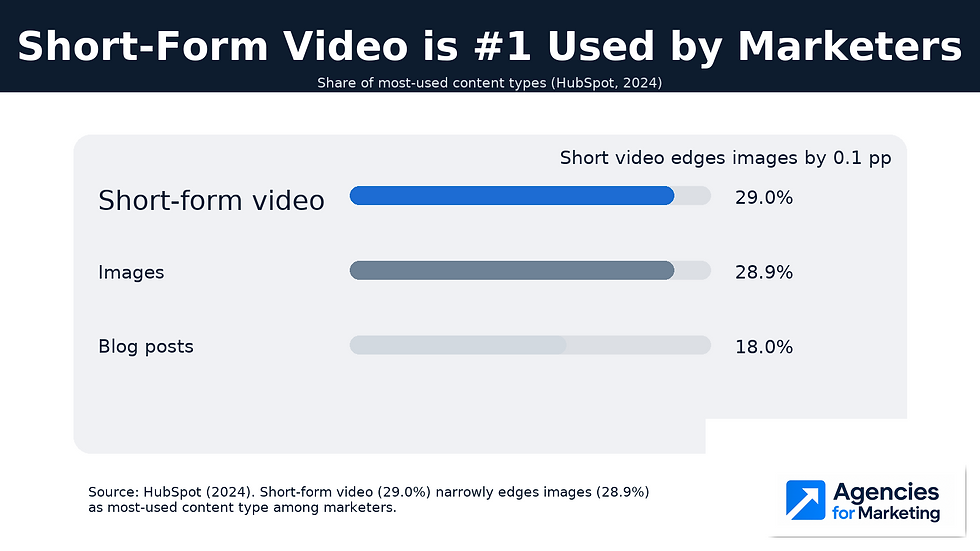
We also see that outsourcing video production is standard, as not every brand has in-house video editors: video production is the second most common service that social media marketers outsource, just behind paid advertising management. This ties back to the earlier discussion on agencies; many creative agencies and specialized production shops are thriving on the demand for social video content. It’s a worthwhile investment, considering consumer expectations: a survey by HubSpot found that short-form videos have the highest ROI and also the highest likelihood of going viral compared to other content forms.
All told, short-form video in the U.S. has transitioned from a trend to a fundamental pillar of marketing. To capture attention in the frenetic digital environment, brands must master the art of concise, compelling video storytelling. Those that have are reaping the rewards in engagement and cultural relevance (think of how fast-food chains or athleisure brands have leveraged viral TikTok challenges). Those that haven’t yet embraced video risk appearing stagnant. As we move forward, expect even more interactive short videos (with AR effects, polls, etc.) and an even greater share of marketing budgets allocated to video content creation and distribution. The screens may be small, but the impact is huge.
Changing Consumer Behavior and Expectations
Amid all these tactical shifts in marketing, one thing remains constant: the consumer is in charge, and their behavior is continually evolving. Understanding modern consumer behavior, especially in the U.S., is critical to crafting effective marketing strategies. One overarching theme is that today’s consumers are digitally empowered, socially connected, and value-conscious, and these traits shape how they respond to marketing.
Firstly, trust and authenticity have become paramount. Consumers, jaded by years of overt advertising, now gravitate to brands and voices they find authentic, relatable, and trustworthy. We saw this in the earlier discussion on influencers: people trust peer-like figures more than corporations. To reiterate, nearly 70% of Americans say they trust information from friends, family, or influencers over a brand’s own communications. This is a profound shift from the era when a slick ad with a celebrity spokesperson might have been enough. Today, a candid customer review on TikTok can carry more weight than a glossy prime-time commercial. Brands have responded by infusing more user-generated content and influencer collaborations into their marketing, essentially borrowing trust from those relatable voices.
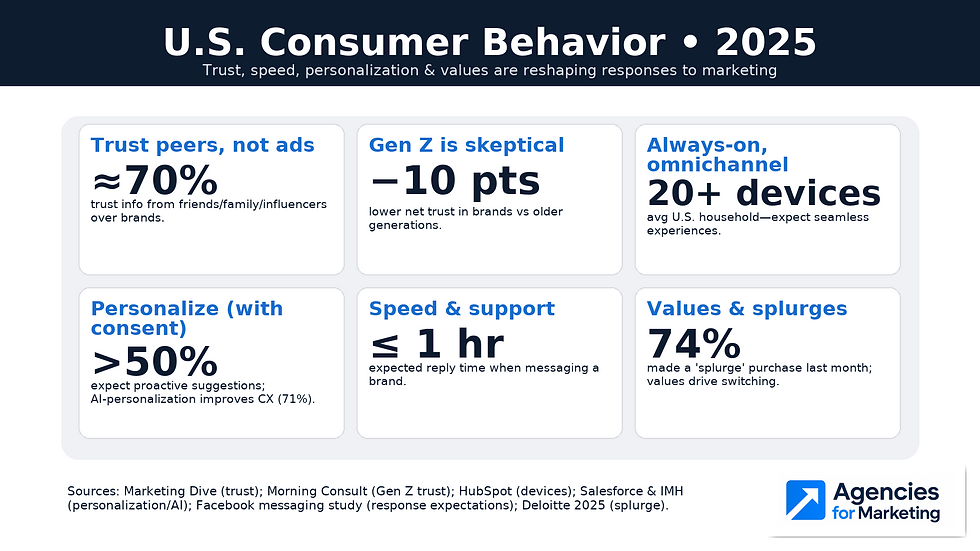
Moreover, younger consumers are more skeptical of brands in general. Surveys indicate that Gen Z adults have significantly lower trust in brands compared to older generations, Morning Consult found Gen Z’s net trust in brands was over 10 points lower than even Millennials or Gen X. Part of this could be a result of growing up online, where they are constantly exposed to marketing and also to information debunking corporate claims. It means Gen Z and young millennials will scrutinize a brand’s actions, not just its ads. They expect companies to be transparent, socially responsible, and aligned with their values. If they sense inauthenticity or deception, they won’t hesitate to call it out (cancel culture, anyone?). On the flip side, if a brand demonstrates honesty and engages openly, it can earn fierce loyalty. For instance, Gen Z highly values authenticity and direct engagement; they appreciate brands that respond to comments, interact in a human voice on social media, and admit mistakes when they happen. Marketing research confirms that among Gen Z, the top qualities they look for in content from brands are authenticity, entertainment value, and reliability. In practice, this means a quirky, unpolished TikTok that shows real employees might be more effective than a perfectly edited ad that feels “too corporate.”
Consumer behavior has also been shaped by the 24/7 digital connectivity and endless choices available. The average U.S. household now has over 20 connected devices, from smartphones and tablets to smart TVs and voice assistants, enabling consumers to engage with content and commerce anytime, anywhere. As a result, consumers have come to expect immediacy and convenience. If a website is slow or a brand isn’t present on their preferred platform, they quickly move on. This has pushed marketers to adopt an omnichannel approach, ensuring a seamless presence across social media, search, email, mobile apps, and physical stores. Consumer journeys often hop between online and offline. For example, a shopper might see a product on a TikTok video, research it on Google, check reviews on Amazon, and then go purchase it in a store. Brands need to be prepared to meet the consumer at each touchpoint with consistent messaging and service.
Another trend is the demand for personalization. Spoiled by algorithms that serve up exactly what they want (think Netflix recommendations or personalized Spotify playlists), consumers now expect marketing to be tailored to them as well. Generic one-size-fits-all messaging is increasingly falling flat. In a Salesforce survey, over half of consumers said they expect brands to anticipate their needs and make relevant suggestions. This is where the earlier topic of AI intersects with consumer behavior. AI is what makes personalization at scale possible. Marketers are using AI to analyze consumer data and segment audiences so they can deliver, say, an email promotion for pet supplies only to the segment of customers who own pets. The payoff for personalization is clear: 71% of marketers report that AI-assisted personalization has improved customer experiences, and consumers respond with higher engagement when content or offers are relevant to their interests or past behavior.
However, there’s a balance to strike, because consumers are also more protective of their privacy. High-profile data breaches and growing awareness of how personal data is used have made people cautious. The coming deprecation of third-party cookies (pushed to 2024/2025) is a reflection of this privacy trend. Marketers in the U.S. are adapting by focusing on first-party data (like loyalty programs or website interactions) and being transparent about data usage. Brands that respect privacy and ask permission (e.g., opt-in subscriptions, clear cookie notices) can build trust, whereas those that are perceived to misuse data may face backlash.
Consumer expectations around speed and customer service have also risen. In the age of Amazon Prime’s two-day (or two-hour) delivery and instant answers via Google, people want things now. This extends to customer support; many consumers expect quick responses on social media or via chat. A Facebook messaging survey found that a majority expect a reply within an hour when messaging a brand. Companies have ramped up real-time support channels and community management on social platforms to keep up. Fast, helpful service is a marketing asset because positive interactions turn customers into repeat buyers and advocates.
Lastly, it’s worth noting changes in consumer content consumption that marketers must adapt to. We’ve already covered the surge in short-form video consumption. Additionally, audio content (like podcasts) has grown, though in marketing terms it’s often used for very targeted campaigns or thought leadership. Streaming television (CTV/OTT) is replacing traditional TV viewership, which pushes marketers to shift TV ad dollars into digital video and streaming platforms where targeting is better. E-commerce behaviors accelerated during the pandemic and have remained elevated. Consumers are very comfortable researching and buying online for even traditionally touch-and-feel categories (groceries, furniture, cars). This means digital marketing and e-commerce are no longer siloed; they’re part of the whole consumer experience that often starts with a Google search or an Instagram ad and ends with a doorstep delivery.
One exceptionally “wow” statistic illustrating modern consumer behavior is the rise of “splurging” and values-driven purchasing despite economic pressures. A June 2025 Deloitte survey found 74% of U.S. consumers made at least one “splurge” purchase in the past month to treat themselves, suggesting that even in tighter times, people seek small indulgences and comfort buys. They’re also paying attention to which brands they support; there’s data indicating consumers (especially younger ones) will switch brands if a company’s ethics or political stance don’t align with their own. This conscious consumerism means marketers have to be mindful of brand image and corporate values, not just product features.
In summary, the modern U.S. consumer is savvy, connected, and discerning. They tune out overt sales pitches but respond to genuine engagement. They want personalized, convenient experiences but won’t compromise on privacy or ethics. They spend more time on digital media than ever, yet crave authenticity and human touch from brands. These behaviors compel marketers to be more customer-centric than ever, essentially putting the consumer in the driver’s seat of marketing strategy. Those who listen to their audience’s preferences, earn trust, and deliver value will thrive. Those who ignore the signs risk irrelevance.
As the CMO of Lenovo, Emily Ketchen, aptly said in a recent industry roundup: “The reality of today is that experiences rise above everything else… Companies that create phenomenal experiences will win.”
In 2025, creating those phenomenal, authentic customer experiences across influencer content, AI-powered interactions, short-form videos, and beyond is the name of the game in marketing.
Final Thoughts
The state of marketing in 2025 is one of rapid evolution, abundant opportunity, and heightened consumer expectations. In the U.S. market, especially, we see an industry transformed by the forces of social media and technology. Influencer marketing has come of age as a powerful channel for authentic engagement. At the same time, debates around in-house versus agency models remind us that having the right talent and perspective is crucial in a complex environment. Artificial intelligence is turbo-charging marketing capabilities, separating those who embrace innovation from those who fall behind. The explosion of short-form video underscores that content is always king, but the format and delivery must adapt to how consumers spend their time. And through it all, consumer behavior keeps shifting: today’s consumers demand transparency, personalization, and meaningful interaction from the brands they choose.
The overarching takeaway is that marketing is no longer about broadcasting a one-size-fits-all message; it’s about building relationships in a dynamic digital world. Successful marketers are the ones who can blend data with creativity: leveraging AI and analytics to understand what consumers want, and then crafting compelling stories (often with the help of influencers or agencies) to meet those desires. They are also the ones who remain agile, ready to pivot to the next TikTok trend or new platform where their audience moves. As we gathered from the expert insights, the human element remains irreplaceable; creativity, strategy, and understanding of nuance are what make campaigns resonate, even as machines handle more execution.
For anyone interested in marketing, the current landscape should be truly exciting. We have more tools and channels at our disposal than ever before to reach the right audience with the right message. The playing field is more level in some ways; a small brand with a clever social strategy can outperform a big spender with a boring message. But it’s also more challenging, because consumers can ignore you with a flick of their finger if you don’t add value or connect authentically. The bar for excellence has been raised.
Crucially, the insights in this report underscore the value of expertise and collaboration. Whether it’s partnering with influential creators who know how to captivate an audience or working with agencies that bring seasoned creative and strategic skills, savvy marketers recognize they don’t have to go it alone. Marketing in 2025 is a team sport between brands, agencies, influencers, and technologies, all coming together to create experiences that delight consumers and drive business results.
As we move forward, one can only imagine what new trends will emerge (the metaverse and Web3 fizzled a bit, but could return; perhaps AR/VR marketing will finally break through). Yet, the core principle likely will remain: know your audience intimately, and meet them where they are with something they genuinely care about. The companies that live by that ethos are seeing winning results even amid the noise. As the data and examples in this report have shown, when marketing is well thought-through and truly customer-centric, it’s not just effective, it can be industry-leading and inspirational.
In the words of Adobe’s CEO Shantanu Narayen: “People who use AI will replace those who don’t.” The sentiment applies broadly; those marketers who embrace change, leverage new tools, and stay focused on delivering real value to consumers will replace those who cling to old playbooks. The state of marketing in 2025 is one of bold innovation built on timeless fundamentals. It’s a challenging field, but for those willing to adapt, it’s also a landscape filled with opportunity to wow audiences and achieve incredible growth.
Sources: The insights and statistics in this report were drawn from a range of credible industry sources.
Influencer Marketing Benchmark Report 2025, Influencer Marketing Hubhttps://influencermarketinghub.com/influencer-marketing-benchmark-report/
More than half of multinational brands plan to boost influencer market spend, WFAhttps://wfanet.org/knowledge/item/2025/03/27/more-than-half-of-multinational-brands-plan-to-boost-influencer-market-spend
Influencer Marketing’s M&A Streak Continues With Mavely Sale, The Wall Street Journalhttps://www.wsj.com/articles/influencer-marketings-m-a-streak-continues-with-mavely-sale-75845022
Influencer marketing success driven by authenticity, matter study says, Marketing Divehttps://www.marketingdive.com/news/influencer-marketing-success-matter-study-2023/643310/
In-housing set for rapid and continued growth at major multinationals, WFAhttps://wfanet.org/knowledge/item/2023/12/20/In-housing-set-for-rapid-and-continued-growth-at-major-multinationals
AI Marketing Benchmark Report 2024, Influencer Marketing Hub https://influencermarketinghub.com/ai-marketing-benchmark-report/
AI and marketing: what the stats show, Martech
AI Will Shape the Future of Marketing, Harvard DCE
AI in Marketing Statistics, SEO.com
Short Form Video Statistics, Vidico
Social Media Video Statistics, Sprout Social
Short-Form Video ROI Statistics, Firework
Short Form Video Marketing Statistics, Yaguara
Video Marketing Statistics & Trends, DesignRush
Word of Mouth Marketing Statistics, GetAmbassador
End of Word-of-Mouth Advertising: Gen Z Trusts Influencers More Than Friends, GoDaddy
Publicis Bets $500 Million on Influencer Marketing With Acquisition of Influential, The Wall Street Journal
Airwallex staff must use AI daily or risk their job, warns boss Jack Zhang, The Australian




